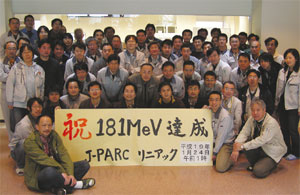On 24 January the linac for the Japan Proton Accelerator Research Complex (J-PARC) successfully accelerated a beam of negative hydrogen ions up to 181 MeV, the design energy for Phase I of the project. The acceleration to the full energy is three months earlier than scheduled.

J-PARC, which is a joint project between the High Energy Accelerator Research Organization (KEK) and the Japan Atomic Energy Agency (JAEA), is being built at Tokai, approximately 120 km north of Tokyo. The accelerator system will comprise a 400 MeV proton linac (181 MeV at the first stage of Phase I), a 3 GeV, 25 Hz Rapid-Cycling Synchrotron (RCS), and a 50 GeV Main Ring Synchrotron. The RCS provides the Materials and Life Science Experimental Facility with a 1 MW beam to generate pulsed muons and pulsed spallation neutrons. Every 3 s, the beam from the RCS is injected four times into the Main Ring, where it is ramped up to 50 GeV (40 GeV at Phase I). Fast extraction then provides a beam for neutrino production and slow extraction sends beam to the Hadron Experimental Facility (HDF). The neutrinos travel to the Super-Kamiokande detector located 295 km to the west, while the slowly extracted beam will produce secondary beams for hyper-nuclei experiments, rare-decay experiments with kaons, hadron-spectroscopy experiments and so on, or will serve primary beam experiments in the HDF.
Construction of J-PARC started in April 2001, and beam commissioning began some five years later. The radio-frequency quadrupole (RFQ) linac accelerated beam up to 3 MeV on 20 November 2006, the very day that the beam commissioning started. A month later, on 19 December, the team accelerated the beam up to 20 MeV using the first tank of the drift-tube linac (DTL), and up to 50 MeV using the second and third tanks the next day. Then at midnight on 19 January all of the 30 separated-type DTL (SDTL) cavities, which are driven by 15 klystrons, were ready for acceleration up to 181 MeV. First, the commissioning team performed a phase scan with each pair of the SDTL cavities driven by one klystron before finally completing the scan through 15 pairs on 24 January.
In each scan the team measured the beam energy by the time-of-flight method. For the initial beam study, the peak current, the beam pulse length and the repetition rate were set at 5 mA, 20 μs and 2.5 Hz, respectively, to avoid possible damage in accelerator components should something go wrong at high beam power. During the commissioning, both the RF power source and cavity system proved to be very stable. This stability together with a very accurate alignment of all of the magnets, especially in the drift-tube linac, were the two major elements that allowed a rapid tuning of the linac, three months before schedule.
Klystrons drive the J-PARC DTL, but it also has quadrupole electromagnets, which are variable-focusing elements. To meet the conflicting requirements of these two systems, the researchers chose an RF acceleration frequency of 324 MHz rather than the widely used 350 MHz; the compact quadrupole electromagnets were developed with the full use of electroforming and wire-cutting techniques; and industry developed the 324 MHz klystrons with a pulsed power of 3 MW (500 μs and 50 Hz) in close collaboration with the J-PARC linac team.
The combination of the 3 MeV RFQ linac and the 324 MHz RF source is now being considered as a best choice for the front end of the proton linac by many future projects at Fermilab, the ISIS spallation neutron source in the UK, the Facility for Antiproton and Ion Research at GSI and the Chinese Spallation Neutron Source. This is partly because 324 or 325 MHz, 3 MW pulsed klystrons are now available, and partly because the frequency is a quarter of L-band frequency, which would be used in a future superconducting International Linear Collider.
The RCS beam commissioning will start in autumn 2007, while the beam commissioning of the Main Ring and the muon and neutron production targets together with their beam transports will start in May 2008. By the end of 2008, the complex will be ready for the J-PARC users. The success of the linac beam commissioning earlier than scheduled is encouraging news.







